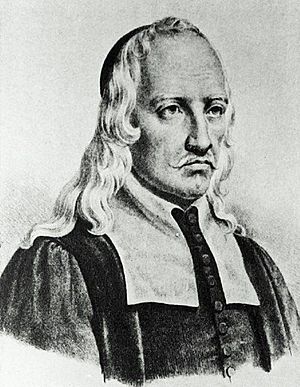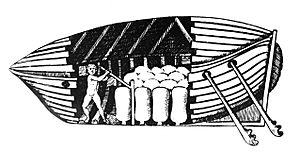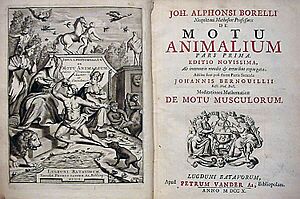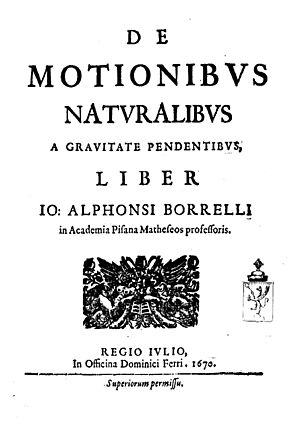Giovanni Alfonso Borelli facts for kids
Quick facts for kids
Giovanni Alfonso Borelli
|
|
|---|---|
 |
|
| Born | 28 January 1608 Naples, Italy
|
| Died | 31 December 1679 (aged 71) Rome, Italy
|
| Nationality | Italian |
| Scientific career | |
| Fields | Physiologist, physicist, mathematician |
| Academic advisors | Benedetto Castelli |
| Notable students | Marcello Malpighi |
Giovanni Alfonso Borelli (born January 28, 1608 – died December 31, 1679) was an Italian scientist. He lived during the Renaissance period. Borelli was a physiologist, a physicist, and a mathematician. He helped create the modern way of doing science. He continued Galileo's idea of testing ideas with observations.
Borelli studied mathematics. He also looked closely at Jupiter's moons. He studied how animals move. This field is called biomechanics. He used microscopy to study tiny parts of blood. He also looked at how plants' stomata (tiny pores) move. He even studied medicine and geology. A powerful person, Queen Christina of Sweden, supported his work.
Contents
Who Was Giovanni Borelli?
Giovanni Borelli was born on January 28, 1608. His birthplace was Naples, Italy. His father was a Spanish soldier named Miguel Alfonso. His mother was Laura Porello.
Borelli later went to Rome. There he studied mathematics with Benedetto Castelli. He attended Sapienza University of Rome. Before 1640, he became a Professor of Mathematics in Messina. In the early 1640s, he met Galileo Galilei in Florence. They became friends. In 1656, Borelli became the head of Mathematics at the University of Pisa. There, he met Marcello Malpighi, an Italian expert on anatomy.
Joining the Accademia del Cimento
Borelli and Malpighi helped start a science group. It was called the Accademia del Cimento. This group began in 1657 but did not last long. Here, Borelli became very interested in how animals move. This is called biomechanics. Malpighi's studies sparked this interest. This interest lasted for the rest of Borelli's life. Because of his work, he is known as the Father of Biomechanics. Borelli was only part of the Accademia for a short time. The group ended soon after he left.
Later Life and Important Work
Borelli went back to Messina in 1668. But he soon had to leave. He was thought to be involved in political problems. He moved to Rome. There, he met Christina of Sweden. She was a former queen who also lived in Rome. Borelli spent his last years without much money. He taught basic math at a convent school. He lived at this convent. His most important book was De Motu Animalium. This means On the Movement of Animals. He never saw it published. Queen Christina and the convent helped pay for it to be printed after he died.
Borelli's Scientific Discoveries
Borelli's biggest discoveries were in biomechanics. This is the study of how living things move. He wrote two important books: De Motu Animalium I and De Motu Animalium II. These books compared animals to machines. He used mathematics to prove his ideas.
How Muscles Work
In the 1600s, scientists started to think that muscles moved by getting shorter. Borelli was the first to say that muscles only move by contracting (getting shorter). He also showed that muscles do not release tiny particles when they move. He proved this with experiments. He cut living muscles and put them in water. No particles came out.
Borelli also understood how we move forward. He realized that our body's center of gravity moves forward first. Then our arms and legs swing to keep us balanced. He also studied the heart. He compared the heart's action to a piston. He figured out that arteries must be stretchy for the heart to work well. Because of these discoveries, Borelli is called the father of modern biomechanics. The American Society of Biomechanics gives the Borelli Award. It is their highest award for research in this area.
Understanding Planet Orbits
Besides biomechanics, Borelli was also interested in physics. He studied how planets orbit. Borelli believed three forces made planets revolve.
- The first force pulled planets toward the sun.
- The second force pushed planets sideways. He thought this push came from sunlight.
- The third force pushed planets outward because the sun was spinning.
He said these forces were like a stone spinning around on a string. Isaac Newton mentioned Borelli's measurements of Jupiter's moons in his famous book, Principia.

Early Submarine Ideas
Borelli is also known for being the first to think of a self-contained underwater breathing device. He also designed an early Submarine. In his design, the air breathed out would be cooled by seawater. This happened after it passed through copper tubes. The helmet was made of brass with a glass window. It was about 0.6 meters (2 feet) wide. This device was probably never built or tested.
Other Writings by Borelli
Borelli wrote several other books and papers, including:
- Delle cagioni delle febbri maligne della Sicilia negli anni 1647 e 1648 (Cosenza, 1649)
- Euclides Restitutus (Pisa, 1658)
- Apollonii Pergaei Conicorum libri v., vi. et vii (Florence, 1661)
- Theoricae Mediceorum planetarum ex causis physicis deductae (Florence, 1666)
- De vi percussionis (Bologna, 1667)
- Meteorologia Aetnea (Reggio, 1669)
- De motionibus naturalibus a gravitate pendentibus (Bologna, 1670)
See also
 In Spanish: Giovanni Alfonso Borelli para niños
In Spanish: Giovanni Alfonso Borelli para niños



